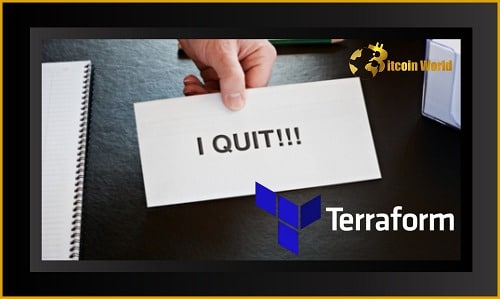The cryptocurrency world is still reeling from the dramatic collapse of Terra (LUNA) and its algorithmic stablecoin, UST. In a stunning turn of events, adding fuel to the firestorm, reports have emerged that Terraform Labs’ legal team has reportedly resigned. Just days after the catastrophic de-pegging of UST and the near-total wipeout of LUNA’s value, the departure of key legal personnel raises serious questions about the future of Terraform Labs and the broader implications for the crypto industry.
Why Did Terraform Labs’ Legal Team Reportedly Resign?
According to reports, three key members of Terraform Labs’ legal team, including general counsel Marc Goldich, regulatory counsel Noah Axler, and Lawrence Florio, have reportedly left the company in May 2022. This exodus comes hot on the heels of UST’s devastating fall from its dollar peg, triggering a massive market downturn that saw Terra’s native token, LUNA, plummet to practically zero, erasing an estimated $40 billion from the crypto market.
While the exact reasons behind their reported departures remain officially unconfirmed and shrouded in speculation, the timing is undeniably significant. Could this be a sign of impending legal challenges, internal disagreements about the handling of the crisis, or simply a desire to distance themselves from the unfolding catastrophe? Let’s break down some potential contributing factors:
- Mounting Legal Scrutiny: The sheer scale of the Terra/LUNA collapse is likely to attract intense regulatory and legal scrutiny. Government agencies and potentially affected investors might be launching investigations into Terraform Labs and its operations. Legal professionals might anticipate a barrage of lawsuits and regulatory inquiries.
- Ethical and Professional Concerns: Lawyers are bound by ethical and professional obligations. If there were concerns about the legality or ethical soundness of Terraform Labs’ actions leading up to or during the collapse, legal team members might feel compelled to resign.
- Internal Disagreements: In times of crisis, disagreements can arise within organizations about strategy and response. It’s possible that the legal team had differing opinions from other leadership within Terraform Labs regarding how to navigate the aftermath of the UST de-pegging.
- Personal Liability: While the specifics would depend on their roles and involvement, legal professionals within a company facing potential legal battles might also be concerned about their own personal liability and reputational risk.
It’s crucial to remember that, at this stage, we are dealing with reports and speculation. Official statements from Terraform Labs or the former legal team members are needed to clarify the situation definitively. However, the optics of a legal team departure during such a critical period are undeniably concerning for the future of Terraform Labs.
The Domino Effect: How UST’s De-pegging Triggered Market Chaos
To understand the gravity of the legal team’s reported departure, it’s essential to grasp the magnitude of the Terra/UST collapse. UST, an algorithmic stablecoin designed to maintain a 1:1 peg with the US dollar, experienced a dramatic and ultimately fatal de-pegging event starting around May 8th. Unlike traditional stablecoins backed by fiat currency reserves, UST’s peg relied on a complex mechanism involving its sister token, LUNA.
Here’s a simplified breakdown of what happened:
- The De-pegging Begins: Large sell-offs of UST initiated the de-pegging, causing its price to drop below $1.
- Algorithmic Response (and Failure): The protocol was designed to maintain the peg by allowing users to burn UST to mint LUNA, and vice versa. The idea was that arbitrage opportunities would incentivize traders to restore the peg. However, in this instance, the selling pressure on UST was overwhelming.
- LUNA’s Hyperinflationary Spiral: As UST’s price plummeted, the algorithm began minting massive amounts of LUNA to try and absorb the UST supply and restore the peg. This led to hyperinflation of LUNA, drastically reducing its value.
- Confidence Collapse: As both UST and LUNA spiraled downwards, investor confidence evaporated. A classic ‘bank run’ scenario unfolded, with everyone rushing to exit their positions, exacerbating the price declines.
- Broader Market Impact: The Terra collapse sent shockwaves throughout the entire cryptocurrency market. Bitcoin, Ethereum, and other cryptocurrencies also experienced significant price drops, highlighting the interconnectedness and systemic risks within the crypto ecosystem. Even Tether (USDT), the largest stablecoin, briefly dipped below its $1 peg, further fueling market anxiety.
The collapse of UST and LUNA serves as a stark reminder of the risks associated with algorithmic stablecoins and the potential for rapid and catastrophic failures in the crypto space. It has also ignited intense debates about the need for stricter regulation and greater investor protection.
In the aftermath, Do Kwon, the co-founder of Terraform Labs, has presented various proposals for Terra’s future, including plans for a new blockchain and token. However, the path forward remains uncertain, and the reported departure of the legal team only adds to the complexity and challenges facing the Terra ecosystem.
The situation with Terraform Labs is still developing. The crypto community and regulators alike will be closely watching to see what unfolds next, and what lessons can be learned from this unprecedented event. The future of Terra, and perhaps the regulatory landscape of stablecoins, hangs in the balance.
Related Reads:
– Ferrari joins the NFT universe through a collaboration with a Swiss…
Disclaimer: The information provided is not trading advice, Bitcoinworld.co.in holds no liability for any investments made based on the information provided on this page. We strongly recommend independent research and/or consultation with a qualified professional before making any investment decisions.


